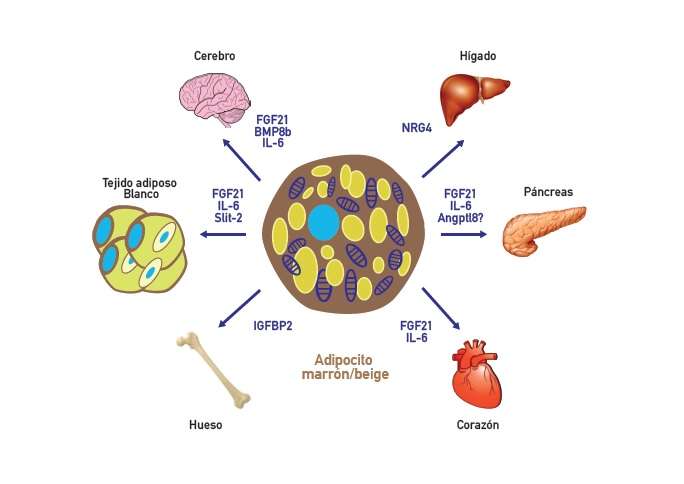Brown adipose tissue is able to secrete factors that activate fat and carbohydrate metabolism

Brown adipose tissue, the main organ generating heat in the body, is also an endocrine organ that secretes signaling factors that activate the fat and carbohydrates metabolism.
This is the main conclusion of an article published in Nature Reviews Endocrinology by the professors Francesc Villarroya, Rubén Cereijo, Joan Villarroya and Marta Giralt, from the Department of Biochemistry and Molecular Biology of the University of Barcelona and CIBER of Physiopathology in Obesity and Nutrition (CIBERobn) of the Institute of Health Carlos III.
Brown adipose tissue: More than burning calories in the body
Brown adipose tissue (BAT) burns calories and makes body heat out of fat. According to the new study, this special kind of fat, the motor of thermogenesis, has an endocrine function that activates lipid and glucidic metabolism in the body, which is a potential therapeutic target to treat pathologies like obesity.
"Traditionally, brown adipose tissue was just seen as an organ to burn calories, but we have learned it has an endocrine biological role," said Professor Francesc Villarroya, member of the Institute of Biomedicine of the University of Barcelona (IBUB) and head of the Research Group in Genetics and Molecular Biology of Mitochondrial Proteins and Associated Diseases.
New perspectives in the physiology of brown adipose tissue
This new perspective on BAT means a revolution similar to the one from years ago with white adipose tissue (WAT), the most common fat. "Until the 1980s," says Villarroya, "people believed WAT was a mere fat storage. From the 1990s on, after discovering leptin as a hormonal factor released by WAT, other adipokines were found (active factors synthesized by this organ)". Therefore, WAT is now understood as an endocrine organ; BAT is being similarly characterized.
According to the experts, BAT activation causes high oxidation in metabolic products to generate heat, during which BAT would also send a series of biochemical signals to the entire organism to activate global oxidizing metabolism. Identifying the released factors, called batokines, is the main challenge of the researchers, apart from discovering how the target organs act, or if there are other secretory tissues, etc.
Among other compounds, FGF21 (fibroblast growth factor 21), neuregulin 4 and IL-6 are the focus of intense research activity. "White adipose tissue, liver, heart, and probably the pancreas and brain (counting the regulation points of feelings of hunger and thirst) are some of the target organs of the batokines," says Villarroya. "We also know that some of the factors released by WAT, such as FGF21, are able to cross the blood-brain barrier and act on brain areas," he said.
From basic research to human physiology
BAT as an endocrine organ has been studied through laboratory animal models and in vitro cell culture. In studies with animal models, there were improvements in the diabetes course and even obesity in mice with small transferred samples of brown adipose tissue. According to the experts, the transferred BAT would release factors that promote glucose metabolism and sensitivity to insulin (in general, a healthier metabolic profile).
"In human physiology," says Villarroya, "it is essential to define if all batokines that are identified in animal models are also present in human BAT and behave the same way. In the future, these batokines could be considered as potential candidates in drug design to treat these diseases. In the case of obese patients with few active BAT, and probably less released batokines, a first therapeutic strategy could be to give them these molecules as drugs."
However, moving this basic research to the clinical field is a challenge for several reasons including the unavailability of samples through human biopsies. For this reason, the team is developing in vitro human cells of brown adipose tissue to allow verifying the results in human physiology.
More information: Francesc Villarroya et al. Brown adipose tissue as a secretory organ, Nature Reviews Endocrinology (2016). DOI: 10.1038/nrendo.2016.136



















